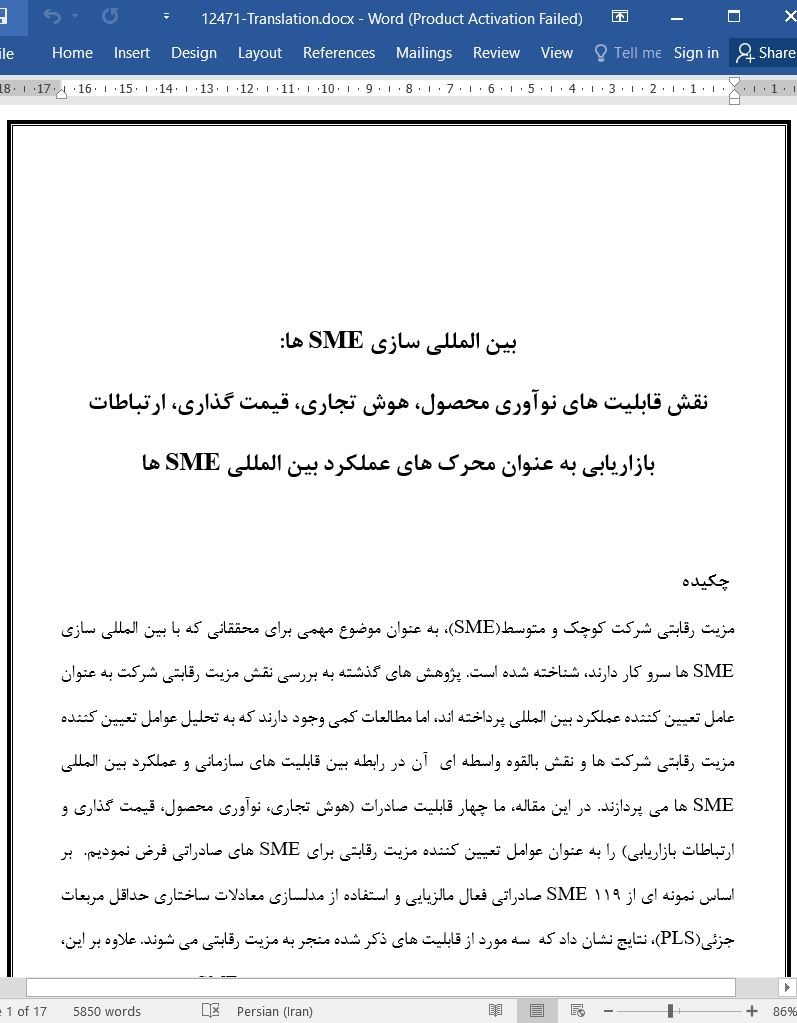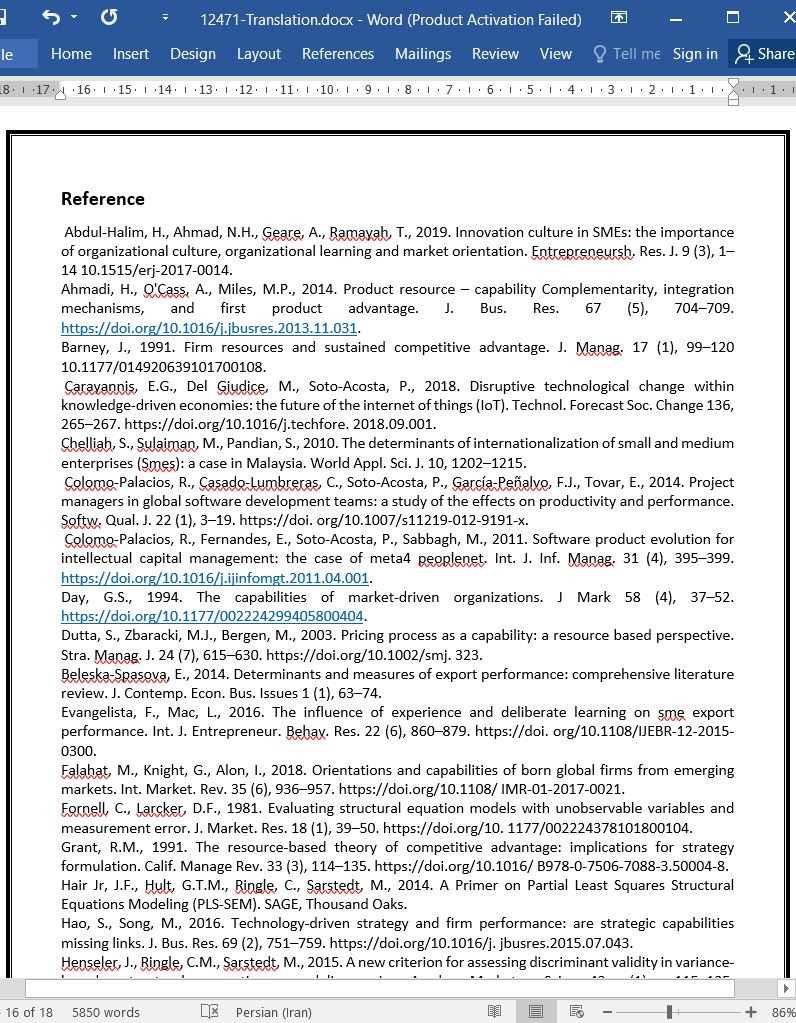
دانلود مقاله بین المللی سازی SME ها
چکیده
مزیت رقابتی شرکت کوچک و متوسط(SME)، به عنوان موضوع مهمی برای محققانی که با بین المللی سازی SME ها سرو کار دارند، شناخته شده است. پژوهش های گذشته به بررسی نقش مزیت رقابتی شرکت به عنوان عامل تعیین کننده عملکرد بین المللی پرداخته اند، اما مطالعات کمی وجود دارند که به تحلیل عوامل تعیین کننده مزیت رقابتی شرکت ها و نقش بالقوه واسطه ای آن در رابطه بین قابلیت های سازمانی و عملکرد بین المللی SME ها می پردازند. در این مقاله، ما چهار قابلیت صادرات (هوش تجاری، نوآوری محصول، قیمت گذاری و ارتباطات بازاریابی) را به عنوان عوامل تعیین کننده مزیت رقابتی برای SME های صادراتی فرض نمودیم. بر اساس نمونه ای از 119 SME صادراتی فعال مالزیایی و استفاده از مدلسازی معادلات ساختاری حداقل مربعات جزئی(PLS)، نتایج نشان داد که سه مورد از قابلیت های ذکر شده منجر به مزیت رقابتی می شوند. علاوه بر این، نتایج نشان داد که مزیت رقابتی، بین قابلیت قیمت گذاری و عملکرد بین المللی SME ها، تنها نقش میانجی دارد. نتایج اصلی این بررسی می تواند برای SME ها و استارتاپ هایی که می خواهند از فرصت های موجود در بازارهای خارجی برخوردار شوند، سودمند باشد.
1.مقدمه
شرکت های کوچک و متوسط(SMEs) نقش مهمی در رشد اقتصادی و فرصت های استخدام در مالزی ایفا می کنند(عبدول- حلیم و همکاران، 2019؛ یان زین و همکاران، 2014). در سال 2017، 97.3 درصد از موسسات تجاری، SME ها بودند و در 37درصد از تولید ناخالص داخلی و66 درصد از کل اشتغال مالزی نقش داشتند. در دیدگاهی که SME ها می توانند از طریق صادرات پوشش بازار خود را گسترش دهند، دولت مالزی با رضایت خاطر SME ها را تشویق می کند تا به منظور رشد بالقوه کسب و کار، بازار بین المللی را بررسی کنند. گرچه، این کار هرگز آسان نیست. SME ها برای رقابت با فعالان صنعتی در سراسر دنیا، باید به مزیت رقابتی دست یابند.
بسیاری از ادبیات عملکرد صادرات به بررسی روابط بین قابلیت ها و عملکرد پرداخته است، اما پژوهش های کمی هم وجود دارد که به تاثیرات قابلیت های سازمانی بر مزیت رقابتی توجه می کنند. علاوه بر این، پژوهش های موجود در زمینه ی عوامل تعیین کننده عملکرد بین المللی در رابطه با تاثیرات قابلیت ها بر عملکرد شرکت نشان دهنده ی نتایج مختلفی است( بلسکا-اسپاسوا،2014). محیط بین المللی سازی پیچیده است و در نتیجه معمولا تمرکز بر بررسی روابط قابلیت- عملکرد، احتمالا از درک گام به گام اینکه آیا علت نتایج متناقض عملکرد-قابلیت، عدم توانایی قابلیت های سازمانی برای ایجاد مزیت رقابتی بوده است یا خیر، غافل شده است.
5. نتیجه گیری ها، محدودیت ها و برای تحقیقات آتی
نتایج نشان داد که قابلیت هوش تجاری، قابلیت نوآوری محصول و قابلیت قیمت گذاری سه توانمندی ضروری هستند که موجب مزیت رقابتی SME های صادراتی مالزی می شوند. به عبارت دیگر، مزایای رقابتی SME های صادراتی مالزی توسط توانایی های شرکت تقویت می شوند تا به هوش تجاری واکنش نشان دهند، در محصولاتشان نوآوری کنند تا از فرصت های بازار استفاده کند و قیمت های معقول پیشنهاد دهند. این پژوهش به تعیین عوامل مزیت رقابتی جهت عملکرد بین المللی SME ها کمک می کند. نشان می دهد که SME های صادراتی به مزایای محصول و قیمت گذاری نیاز دارند. یافته های این پژوهش با کار کالکا و مورگان(2017) موافق است که به تقارن بین مزایای رقابتی مختلف تاکید دارند. علاوه بر این، نتایج ما نشان داد که تنها قابلیت قیمت گذاری به طور معناداری تاثیر غیر مستقیم بر عملکرد بین المللی SME ها دارد. این موضوع نقش حیاتی قابلیت قیمت گذاری برای موفقیت بین المللی را تایید می کند. از اینرو، حتی اگر شرکتی بتواند از طریق نوآوری محصول به مزیت رقابتی دست یابد، قیمت گذاری معقول برای بهره برداری از نوآوری محصول ضروری است.
Abstract
Small and medium enterprise (SME) competitive advantage has been recognized as an important topic for researchers dealing with SME internationalization. Previous studies have long discussed the role of firm competitive advantage as a determinant of international performance, but there are few studies analyzing the determinants of firm competitive advantage and its potential mediating role in the relationship between organizational capabilities and SMEs' international performance. In this paper, we hypothesize four essential export capabilities (market intelligence, product innovation, pricing, and marketing communication) as determinants of competitive advantage for exporting SMEs. Based on a sample of 119 active exporting Malaysian SMEs and using partial least squares (PLS) structural equation modeling, the results revealed that three of the mentioned capabilities lead to competitive advantage. In addition, results indicated that competitive advantage only acts as a mediator between pricing capability and SMEs' international performance. The main conclusions of this investigation can be valuable to SMEs and startups that intend to explore or exploit opportunities in foreign markets.
1. Introduction
Small and medium enterprises (SMEs) play an important role for both economic growth and employment opportunities in Malaysia (Abdul-Halim et al., 2019; Yan Xin et al., 2014). In 2017, 97.3% of business establishments were SMEs and they contributed to 37% of the gross domestic product and 66% of the total employment in Malaysia (SME Corp, 2019). In view that SMEs can expand their market coverage through exporting, the government of Malaysia contently encourages SMEs to explore the international market for potential business growth. However, this has never been an easy task. SMEs need to achieve competitive advantage in order to compete with other industry players around the world.
Most of the export performance literature has investigated the relationships between capabilities and performance, but few studies considered the effects of organizational capabilities on competitive advantage. In addition, studies on the determinants of international performance obtained mixed results regarding the effects of capabilities on firm performance (Beleska-Spasova, 2014). The internationalization environment is complex and, therefore, the often focus on investigating capability-performance relationships has probably omitted a step-bystep understanding on whether inconsistent capability-performance results are because some of the organizational capabilities fail to produce competitive advantages.
5. Conclusions, limitations and future research
The results revealed that market intelligence capability, product innovation capability and pricing capability are three essential capabilities that lead to competitive advantage of Malaysian exporting SMEs. In other words, competitive advantages of Malaysian exporting SMEs are supported by the companies’ abilities to respond to market intelligence, innovate on their products to exploit market opportunities and offer reasonable prices. This study contributes to shed light on the determinants of competitive advantages for SMEs’ international performance. It reflects that exporting SMEs rely on both product advantages and price advantages. The finding is consistent with the work of Kaleka and Morgan (2017), which emphasized asymmetries between different competitive advantages. In addition, our results indicated that only the pricing capability has an indirect significant effect on SMEs’ international performance. This confirms the critical role of the pricing capability for international success. Thus, even though a firm could achieve competitive advantage through product innovation, a reasonable pricing may be essential to capitalize product innovation.
Hypothesis 1. There is a positive relationship between exporting SMEs' market intelligence capability and competitive advantage.
Hypothesis 2. There is a positive relationship between exporting SMEs' product innovation capability and competitive advantage.
Hypothesis 3. There is a positive relationship between exporting SMEs’ pricing capability and competitive advantage.
Hypothesis 4. There is a positive relationship between exporting SMEs’ marketing communication capability and competitive advantage.
Hypothesis 5. There is a positive relationship between SMEs's competitive advantage and SMEs' international performance.
Hypothesis 6. Competitive advantage mediates the relationship between SMEs' market intelligence capability and SMEs' international performance.
Hypothesis 7. Competitive advantage mediates the relationship between SMEs' product innovation capability and SMEs' international performance.
Hypothesis 8. Competitive advantage mediates the relationship between SMEs' pricing capability and SMEs' international performance.
Hypothesis 9. Competitive advantage mediates the relationship between SMEs' marketing communication capability and SMEs' international performance.
فرضیه 1. بین قابلیت هوش تجاری SME صادراتی و مزیت رقابتی رابطه مثبتی وجود دارد.
فرضیه 2. بین قابلیت نوآوری محصول SME های صادراتی و مزیت رقابتی رابطه مثبت وجود دارد.
فرضیه 3. بین قابلیت قیمت گذاری SME های صادراتی و مزیت رقابتی رابطه مثبت وجود دارد.
فرضیه 4. بین قابلیت ارتباطات بازاریابی SME های صادراتی و مزیت رقابتی ارتباط مثبت وجود داد.
فرضیه 4. بین مزیت رقابتی SME ها و عملکرد بین المللی SME ها رابطه مثبت وجود دارد.
فرضیه 6. مزیت رقابتی رابطه بین قابلیت هوش تجاری SME و عملکرد بین المللی SME ها را میانجی می کند.
فرضیه 7. مزیت رقابتی رابطه بین قابلیت نوآوری محصول و عملکرد بین المللی SME ها را میانجی می کند.
فرضیه 8. مزیت رقابتی رابطه بین قابلیت قیمت گذاری SME ها و عملکرد بین المللی SME ها را میانجی می کند.
فرضیه 9. مزیت رقابتی رابطه بین قابلیت ارتباطات بازاریابی SME ها و عملکرد بین المللی SME ها را میانجی می کند.
چکیده
1. مقدمه
2. برررسی پیشینه پژوهش و طرح فرضیه ها
2.1. قابلیت های SME های صادراتی و مزیت رقابتی
2.2. مزیت رقابتی SME های صادراتی و عملکرد بین المللی SME ها
3. روش شناسی تحقیق
3.1. داده ها
3.2. اندازه گیری متغیرها
3.3. مدل اندزه گیری
4. نتایج تجربی
5. نتیجه گیری ها، محدودیت ها و برای تحقیقات آتی
منابع
ABSTRACT
1. Introduction
2. Literature review and hypotheses development
2.1. Exporting SMEs' capabilities and competitive advantage
2.2. Exporting SMEs' competitive advantage and SMEs' international performance
3. Research methodology
3.1. Data
3.2. Measures of variables
3.3. Measurement model
4. Empirical results
5. Conclusions, limitations and future research
Reference
- اصل مقاله انگلیسی با فرمت ورد (word) با قابلیت ویرایش
- ترجمه فارسی مقاله با فرمت ورد (word) با قابلیت ویرایش، بدون آرم سایت ای ترجمه
- ترجمه فارسی مقاله با فرمت pdf، بدون آرم سایت ای ترجمه



